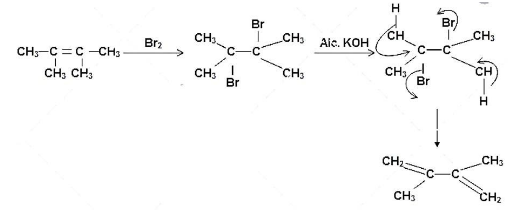
2, 3 dimethyl but-2-ene when reacted with bromine forms a compound which upon heating with alcoholic $ \text{KOH} $ produces the following major product:
(A)

(B)

(C)

(D)





Answer
535.2k+ views
Hint: The addition of alcoholic $ \text{KOH} $ to an alkyl halide followed by heating the substance leads to the formation of an alkene and this takes place through an elimination reaction. The hydroxyl atom of the alcohol acts as a string base that helps in the extraction of a beta hydrogen atom from the alkyl halide.
Complete Stepwise Solution:
The reaction of 2, 2 dimethyl but-2-ene with bromine can be given as follows:

In the first step, the bromine molecule adds onto the carbon atoms of the double bond to form 2,3 – dibromo, 2,3-dimethyl butane. The addition of the alcoholic potassium hydroxide solution follows next that results in the formation of the 2,3-dimethyl but-1, 3- dinene. This is from the attack of the hydroxyl group of alcoholic potassium hydroxide that attacks the beta-hydrogen atoms with respect to the bromine atoms and two beta-elimination reactions take place in the molecule leading to the formation of the diene.
Hence, the compound formed when 2, 3 dimethyl but-2-ene reacts with bromine forms a compound which upon heating with alcoholic $ \text{KOH} $ is 2,3-dimethyl but-1, 3- dinene, option B.
Note:
The bromination of the alkenes or the alkynes is a non-stereoselective reaction as the bromine molecule being non-polar, it adds onto the alkene or the alkyne non-selectively. Potassium hydroxide when dissolved in water and that aqueous solution is added to any alkene or alkyne then it behaves as a strong base that adds to the double bond and forms the alcohol from the alkene and alkynes.
Complete Stepwise Solution:
The reaction of 2, 2 dimethyl but-2-ene with bromine can be given as follows:

In the first step, the bromine molecule adds onto the carbon atoms of the double bond to form 2,3 – dibromo, 2,3-dimethyl butane. The addition of the alcoholic potassium hydroxide solution follows next that results in the formation of the 2,3-dimethyl but-1, 3- dinene. This is from the attack of the hydroxyl group of alcoholic potassium hydroxide that attacks the beta-hydrogen atoms with respect to the bromine atoms and two beta-elimination reactions take place in the molecule leading to the formation of the diene.
Hence, the compound formed when 2, 3 dimethyl but-2-ene reacts with bromine forms a compound which upon heating with alcoholic $ \text{KOH} $ is 2,3-dimethyl but-1, 3- dinene, option B.
Note:
The bromination of the alkenes or the alkynes is a non-stereoselective reaction as the bromine molecule being non-polar, it adds onto the alkene or the alkyne non-selectively. Potassium hydroxide when dissolved in water and that aqueous solution is added to any alkene or alkyne then it behaves as a strong base that adds to the double bond and forms the alcohol from the alkene and alkynes.
Recently Updated Pages
Master Class 11 Economics: Engaging Questions & Answers for Success

Master Class 11 English: Engaging Questions & Answers for Success

Master Class 11 Social Science: Engaging Questions & Answers for Success

Master Class 11 Biology: Engaging Questions & Answers for Success

Class 11 Question and Answer - Your Ultimate Solutions Guide

Master Class 11 Business Studies: Engaging Questions & Answers for Success

Trending doubts
What is meant by exothermic and endothermic reactions class 11 chemistry CBSE

10 examples of friction in our daily life

One Metric ton is equal to kg A 10000 B 1000 C 100 class 11 physics CBSE

Difference Between Prokaryotic Cells and Eukaryotic Cells

What are Quantum numbers Explain the quantum number class 11 chemistry CBSE

1 Quintal is equal to a 110 kg b 10 kg c 100kg d 1000 class 11 physics CBSE




